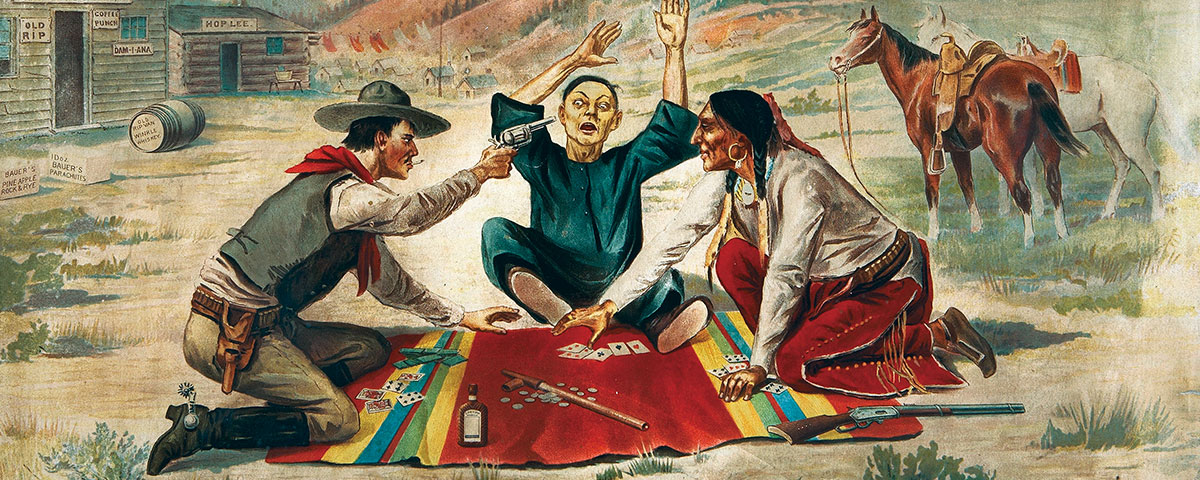In July 1861 painter Emanuel Leutze secured a commission to render a 20-by-30-foot stereochrome mural in a stairwell of the U.S. Capitol. More adept at patriotic sentimentalism than subtle nuance, Leutze created Westward the Course of Empire Takes Its Way, a grandiloquent portrait of Manifest Destiny—pioneers on a divine pilgrimage, emerging from cold shadows of the war-torn East to bathe in the warm light of the glowing Western horizon. Mark Twain lampooned Leutze’s schmaltz in Life on the Mississippi, appropriating the painting’s title in the line “Westward the Jug of Empire takes its way.” The satirist floated an alternative narrative: “The earliest pioneer of civilization, is never the steamboat, never the railroad, never the newspaper, never the Sabbath-school, never the missionary—but always whiskey!” According to Twain, those who followed the whiskey were, in descending order, missionaries, poor immigrants, traders, the miscellaneous rush, gamblers, desperadoes, highwaymen and “the smart chap who has bought up an old grant that covers all the land.” Cleaning up after them were undertakers, vigilante committees and lawyers.
Regardless, the legend of the West is hard to resist. Present-day whiskey bottles, modern reincarnations of Twain’s “Jug of Empire,” likewise pursue Leutze’s romantic theme, with images of buffalo and frontiersmen and fonts reminiscent of Hollywood wanted posters. Bulleit Bourbon bottles are even shaped like—take your pick—tombstones or apothecary bottles of the sort peddled by snake oil salesmen. The iconography raises some uncomfortable questions, for Leutze ascribed virtues like perseverance and guts to what might also be described as a booze-fueled land grab. Here’s how early Moravian missionary John Heckewelder described the frontier ethos: “When the object is to murder Indians, strong liquor is the main article required; for when you have them dead drunk, you may do to them as you please, without running the risk of losing your life.”
It is easy to glorify a free West detached from intrusive government meddling, but its “benefits” were largely a myth. It also begs the question: What did free-flowing whiskey from the Old West really taste like? Popular nicknames offer a hint: mountain howitzer, coffin varnish, chain lightning, strychnine and tangleleg. Absent regulations, trademark protections and the bureaucracy that enforces them, frontier whiskey lived up to its colorful monikers. Before the landmark consumer protection laws passed during President Theodore Roosevelt’s administration, nothing prevented people from labeling a product, say, Pure Kentucky Bourbon Whiskey, Aged 10 Years, even if no part of the label were accurate. What consumers often got instead were rough base spirits, dressed up with additives like burnt sugar to add color and mask flaws.
In the decades following the Civil War only a fraction of the product on the market consisted of the quality spirits a modern consumer might recognize as “straight” bourbon or rye whiskey—that made purely from specified grains, distilled at a proof lower than 160 and aged in a charred new oak barrel for at least two years. Much of what was sold originated with bulk operators who specialized in manufacturing tasteless, high-proof spirits marketed today as vodka (after the proof is lowered with water) or as fuel or for use in other industrial purposes. These pure ethanol products, almost indistinguishable from one distillery to the next, are commonly known as grain neutral spirits.
Some westbound whiskey might have started out as quality bourbon or rye, but en route to the saloons middleman “rectifiers” often mixed it with water or grain neutral spirits to inflate the supply and boost profits. Lack of oversight often tipped the scales in favor of corner cutters. Lax trademark enforcement allowed them to steal label designs such as Old Taylor Bourbon to move a product actually distilled from a low-grade variety of molasses called “blackstrap,” dressed up with adulterants like burnt sugar, glycerin, prune juice or various acids.
An 1880s ad (see above) for rectified whiskies produced by Chicago’s A. Bauer & Co. offers a less savory alternative to the romantic West depicted in Leutze’s painting. It features a cowboy, a Chinese man and an American Indian playing poker atop a blanket. The Chinese man has just claimed the pot with three aces, but the cowboy moves to take the loot at gunpoint, while the Indian makes a grab for the distracted cowboy’s whiskey. In the background is Sam Toughnut’s saloon, which hangs out shingles for several of Bauer’s whiskies.
In 1897 whiskey businessmen such as Edmund Haynes Taylor Jr. and George Garvin Brown urged Congress to pass the Bottled-in-Bond Act, making the federal government the guarantor of a whiskey’s quality. Affixed to the product, the Bottled in Bond stamp assured consumers the spirit originated with the maker on the label, was made all at one distillery and was aged four years or longer in a warehouse supervised by federal officials. In 1906 Roosevelt signed the Pure Food and Drug Act, which further enforced proper labeling, and in 1909 President William Howard Taft clarified the rules regarding whiskey, putting in place many of the standards that remain today. In the end it took an unlikely coalition of scientists in white lab coats, litigious capitalists and, yes, reform-minded bureaucrats to transform American whiskey into a world-class sip.
Reid Mitenbuler is the author of Bourbon Empire: The Past and Future of America’s Whiskey (Viking, 2015). Originally published in the December 2015 issue of Wild West.






